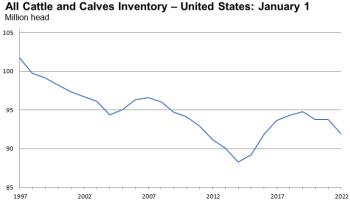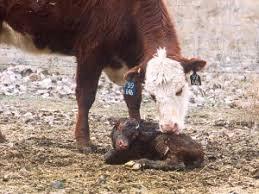 A report from Oklahoma State University documented a two-percent decline in cattle inventory on July 1, 2022, compared to the corresponding date in the preceding year. Dr. Derrell Peel stated, "there are indications that drought impacts have accelerated sharply in the southern plains during July". He added, "Cattle producers are destocking at a rapid rate as pasture conditions deteriorate".
A report from Oklahoma State University documented a two-percent decline in cattle inventory on July 1, 2022, compared to the corresponding date in the preceding year. Dr. Derrell Peel stated, "there are indications that drought impacts have accelerated sharply in the southern plains during July". He added, "Cattle producers are destocking at a rapid rate as pasture conditions deteriorate".
Dr. David Anderson of Texas A&M noted, "We haven’t had this kind of movement of cows to market in a decade since 2011 that was our really last big drought". Regional cow slaughter plants have experienced high volume of sales in both Oklahoma and Texas. This has implications for the availability of slaughter stock from pasture and feed lots in 2024 when additional packing capacity is projected to come on line together with the existing and expanded production from the four major packers.

Since the 2020 restrictions on output imposed by COVID that demonstrated vulnerability in the beef supply chain, a number of entrepreneurs and production groups have proposed establishing beef packing plants. Small regional establishments will receive funding from USDA and from state agencies. Major plants processing up to 2,000 head per day and costing between $0.5 to $1.0 billion have been proposed. Critics have noted that if these facilities are erected and commence production in 2024, they will have difficulty in sourcing live animals given the current depletion of the beef cow herd. Industry insiders have also pointed to restrictions on availability of labor for large beef plants. Promoters of new facilities may have underestimated the competitive aspects of the beef industry with domination by the four major packers with established markets and the possibility of predatory pricing to the detriment of industry newcomers.
animals given the current depletion of the beef cow herd. Industry insiders have also pointed to restrictions on availability of labor for large beef plants. Promoters of new facilities may have underestimated the competitive aspects of the beef industry with domination by the four major packers with established markets and the possibility of predatory pricing to the detriment of industry newcomers.